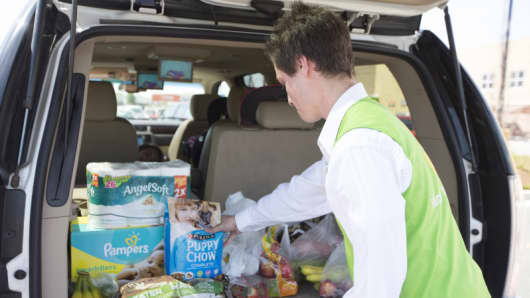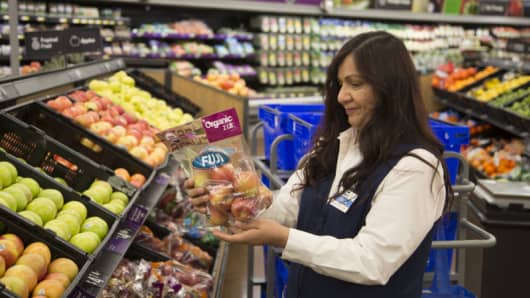
Source: Walmart.com
Customer makes online grocery pickup at Wal-Mart
The online grocery business is expected to heat up over the holidays as major players beef up e-commerce efforts and expand into new markets.
Driving the growth is the ramp up of fast grocery delivery services by Amazon and others and the expansion of curbside pickup by Wal-Mart Stores. Also, tech-savvy consumers have an increased comfort level with buying fresh foods online and see ordering groceries through an app as a way to save time and avoid checkout lines.
"Online grocery will take off this holiday season, with consumers buying more turkeys, cranberry sauce and stuffing online than ever, as a result of Wal-Mart, Kroger and others ramping up their e-grocery services," said John Mercer, a senior analyst and research head at Fung Global, a retail and technology think tank.

Source: Walmart.com
Employee fills online grocery order at Wal-Mart store
Indeed, Wal-Mart has expanded the range of items this year so consumers looking to avoid crowds at the grocery store this Thanksgiving can order for curbside pickup not just a turkey and all the fixings but a roasting pan, gravy boat and other food prep items. With a minimum $30 grocery order, the pickup is free and available the same day.
The Arkansas-based retailer sells upward of 30,000 food items — including fresh produce, meats, dairy, organic groceries and gluten-free items, among other things. It uses personal shoppers to fulfill the order and currently serves about 600 locations, including some just added within the last several weeks.
"We've really expanded our footprint and our offering in a very aggressive way just this past year," said Ravi Jariwala, a spokesman for Wal-Mart. "I would say we are probably one of the fastest-growing online grocers in the U.S., just based on the fact that at the start of the fall last year we were in five markets. Today we're in 100."
"We believe that the grocery category is likely to be one of the next key areas of e-commerce growth"-Jessica Schoen Mace, Nomura analyst
Online grocery purchases are expected to rise nearly 20 percent this year, according to market researcher Technomic. In contrast, the traditional brick-and-mortar supermarkets are projected to see just 2 percent growth in consumer spending.
Analysts say the holidays are particularly important for the online grocery delivery sector because there may be more consumers using it not just for restocking the refrigerator and pantry but for fill-in orders when they forget something from the supermarket and don't have time to run out and get it.
As it turns out, online grocery shoppers also spend more on average than regular brick-and-mortar store customers and are more apt to continue shopping in cyberspace after they've experienced the service, according to research group Kantar Worldpanel.
"We believe that the grocery category is likely to be one of the next key areas of e-commerce growth," Nomura analyst Jessica Schoen Mace said in a research note last month.
As of June, only about 1.4 percent of groceries in the roughly $800 billion grocery market were purchased online in the U.S., according to Kantar data. Fung Global expects that number to reach 2 percent or more in 2017.
"Consumers are starting to get more exposure to produce that's selected by a third party — and there's more trust," said Erik Thoresen, a principal at Technomic. "I think this will be an important year for us to kind of get a sense of what consumer usage and adoption will be moving forward."
Thoresen calls Amazon a "game changer" in terms of knowing what's possible when it comes to buying groceries and getting them delivered the same day. The e-commerce company offers grocery delivery services under several programs, including AmazonFresh, Prime Now and Prime Fresh.
While Amazon's grocery delivery services are not available in all markets, the Seattle-based company has been expanding in the past year and its logistics system has enabled it to provide faster delivery of a large number of food items — both packaged and fresh. Also, Amazon lowered its grocery subscription fee last month, a move analysts saw as an attempt to stay competitive with Wal-Mart.
"We're very happy with the Amazon Fresh and we have now expanded quite a bit," Amazon.com CFO Brian Olsavsky said last month in discussing the company's third-quarter earnings.
Yet there are signs Amazon maybe seeing growing pains with its direct-to-consumer grocery deliveries. For one, AmazonFresh's website cautions, "Due to customer demand, delivery windows may be limited." Amazon did not respond to requests for comment for this story.
Besides Amazon, other warehouse-based food delivery services include Peapod, Fresh Direct and MaxDelivery. Also, newer entrants have stiffened competition in the category
"We will do nine figures of revenue this year," said Chieh Huang, co-founder and CEO of Boxed.com, a wholesale delivery service selling grocery products and other household items. Just 2 ½ years ago the business was still in Huang's New Jersey garage and now the company operates four fulfillment centers nationally and delivers in all the lower 48 states.
At Kroger, the company's ClickList online grocery service is growing and allows consumers at more than 500 locations to select from more than 40,000 items and pick up orders at stores. Last week, the Cincinnati-based supermarket operator told analysts at its investor conference that the ClickList rollout is progressing well
Also, Instacart, an app-based retail delivery service, has partnered with Kroger and several other major retailers including Whole Foods, Costcoand Target, and this fall began expanding in key U.S. markets.
"For the stores, it's a way to maintain their market share," said Patricia Orsini, an analyst at eMarketer. "That's why you're seeing all this growth happening."
Target offers Instacart in three markets at present and the retailer also allows customers to select an Order Pickup option for packaged food items, or nonperishables.
There's also a cash-back online service known as Shop.com, which has ties to Wal-Mart, Jet.com (recently acquired by Wal-Mart) and others. It gets a commission from retailers starting at 2 percent and sells over a million items, including snacks, beverages and baby foods, as well as other packaged foods and nongrocery products.
"We stick to mainly the dry goods area," said Eddie Alberty, vice president of strategic partnerships at Shop.com. "For us it's kind of a walk, crawl and run approach."
No comments:
Post a Comment